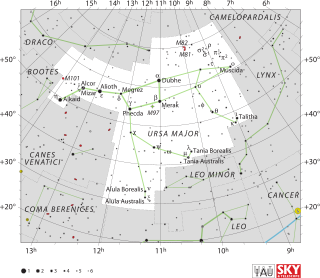Iota Ursae Majoris
| Observation data Epoch J2000 Equinox J2000 | |
|---|---|
| Constellation | Ursa Major |
| Right ascension | 08h 59m 12.45362s[1] |
| Declination | +48° 02′ 30.5741″[1] |
| Apparent magnitude (V) | 3.14[2]/10.1/10.3 |
| Characteristics | |
| Spectral type | A7 IV[3] + dM1 J |
| U−B color index | +0.08[2] |
| B−V color index | +0.19[2] |
| Variable type | Suspected |
| Astrometry | |
| Radial velocity (Rv) | +9.0[4] km/s |
| Proper motion (μ) | RA: -441.29[1] mas/yr Dec.: -215.32[1] mas/yr |
| Parallax (π) | 68.92 ± 0.16 mas[1] |
| Distance | 47.3 ± 0.1 ly (14.51 ± 0.03 pc) |
| Details | |
| ι UMa A | |
| Rotational velocity (v sin i) | 154[5] km/s |
| Age | 620[6] Myr |
| Other designations | |
| Database references | |
| SIMBAD | data |
Iota Ursae Majoris (Iota UMa, ι Ursae Majoris, ι UMa) is a star system in the northern circumpolar constellation of Ursa Major. It has an apparent visual magnitude of 3.14,[2] making it visible to the naked eye and placing it among the brighter members of this constellation. Based upon parallax measurements, it is located at a distance of 47.3 light-years (14.5 parsecs) from Earth. It has the traditional names Talitha, Talitha Borealis and Alphikra Borealis, and was also dubbed Dnoces ("Second," backwards) after Edward H. White II, an Apollo 1 astronaut. The name was invented by his fellow astronaut Gus Grissom as a practical joke.[8]
The Iota Ursae Majoris system is composed of two binary stars. The brightest component is a white A-type subgiant. It is a spectroscopic binary whose components have an orbital period of 4028 days. The companion binary is composed of the 9th magnitude and 10th magnitude stars. These two stars orbit around each other with a period of 39.7 years, and are separated by roughly 0.7 arcseconds, or at least 10 AU. This pair may be the source of the X-ray emission detected from this system.[9]
The two binary systems orbit around each other once every 818 years. The apparent separation between the two binaries is rapidly decreasing as they follow their orbits. In 1841 when the B component was first discovered, they had a separation of 10.7 arcseconds, or at least 156 AU. By 1971 their separation had decreased to 4.5 arcseconds, or at least 66 AU. This system appears to be dynamically unstable with a high likelihood and may become disrupted on a time scale on the order of 105 years.[10]
Name and etymology
- The traditional name Talitha' (share with κ UMa) comes from the Arabic phrase Al Fiḳrah al Thalitha "the third spring, or leap, of the ghazal".[11] The term Borealis meaning "the north side" in Latin.
- In Chinese, 三台 (Sān Tái), meaning Three Steps, refers to an asterism consisting of ι Ursae Majoris, κ Ursae Majoris, λ Ursae Majoris, μ Ursae Majoris, ν Ursae Majoris and ξ Ursae Majoris. Consequently, ι Ursae Majoris itself is known as 三台一 (Sān Tái yī, Template:Lang-en) and 上台一 (Shàng Tái yī, Template:Lang-en).[12]
See also
- Gamma Velorum, informally named Regor for astronaut Roger B. Chaffee
- Gamma Cassiopeiae, informally named Navi for astronaut Virgil Ivan "Gus" Grissom
References
- ^ a b c d e van Leeuwen, F. (November 2007). "Validation of the new Hipparcos reduction". Astronomy and Astrophysics. 474 (2): 653–664. arXiv:0708.1752. Bibcode:2007A&A...474..653V. doi:10.1051/0004-6361:20078357.
- ^ a b c d Johnson, H. L.; et al. (1966). "UBVRIJKL photometry of the bright stars". Communications of the Lunar and Planetary Laboratory. 4 (99). Bibcode:1966CoLPL...4...99J.
- ^ Morgan, W. W.; Abt, H. A. (February 1972), "The spectral classification of the F stars of intermediate luminosity", Astronomical Journal, 77: 35–37, Bibcode:1972AJ.....77...35M, doi:10.1086/111242
- ^ Evans, D. S. (June 20–24, 1966), Batten, Alan Henry; Heard, John Frederick (eds.), The Revision of the General Catalogue of Radial Velocities, University of Toronto: International Astronomical Union, Bibcode:1967IAUS...30...57E
{{citation}}: Unknown parameter|booktitle=ignored (help) - ^ Royer, F.; Zorec, J.; Gómez, A. E. (February 2007), "Rotational velocities of A-type stars. III. Velocity distributions", Astronomy and Astrophysics, 463 (2): 671–682, arXiv:astro-ph/0610785, Bibcode:2007A&A...463..671R, doi:10.1051/0004-6361:20065224
- ^ Su, K. Y. L.; et al. (December 2006), "Debris Disk Evolution around A Stars", The Astrophysical Journal, 653 (1): 675–689, arXiv:astro-ph/0608563, Bibcode:2006ApJ...653..675S, doi:10.1086/508649
- ^ "iot UMa -- Spectroscopic binary". SIMBAD Astronomical Object Database. Centre de Données astronomiques de Strasbourg. Retrieved 2012-02-25.
- ^ "Post-landing Activities", Apollo 15 Lunar Surface Journal, NASA. Commentary at 105:11:33.
- ^ De Rosa, R. J.; et al. (July 2011), "The Volume-limited A-Star (VAST) survey - I. Companions and the unexpected X-ray detection of B6-A7 stars", Monthly Notices of the Royal Astronomical Society, 415 (1): 854–866, arXiv:1103.4363, Bibcode:2011MNRAS.415..854D, doi:10.1111/j.1365-2966.2011.18765.x
{{citation}}: CS1 maint: unflagged free DOI (link) - ^ Zhuchkov, R. Ya.; Orlov, V. V.; Rubinov, A. V. (January 2006), "Dynamical stability of the quadruple systems HD 68255/6/7 and HD 76644", Astronomy Reports, 50 (1): 62–67, Bibcode:2006ARep...50...62Z, doi:10.1134/S1063772906010070
- ^ Richard Hinckley Allen :Star Names — Their Lore and Meaning - Ursa Major, the Greater Bear
- ^ Template:Zh icon (Activities of Exhibition and Education in Astronomy) 天文教育資訊網 2006 年 6 月 21 日
External links
- NightSky Friday: Rotanev, Derf, Navi, and other Backward Star Names – Space.com article
- ARICNS
- Talitha by Professor Jim Kaler.

